Group B of the 2022 World Cup has just been blown wide open after Friday morning’s surprise result.
Iran, coming into the game off the back of a 6-2 hammering suffered at the hands of England, put Wales to the sword on Black Friday, winning 2-0 at the Ahmed bin Ali Stadium in Ar-Rayyan.
Had Rob Page’s Welsh side been victorious on the day, Team Melli would have been mathematically eliminated from the tournament, the first nation to be knocked out in this controversial rendition of the competition.
However, the newfound stoppage time system gave Iran the breakthrough they needed. In the 98th minute, Rouzbeh Cheshmi curled the ball past Danny Ward against a ten-man Wales to give hope to the Middle Eastern side amid the backdrop of protests, fear and dismay back home.
Cheshmi’s wonder strike was followed up by a beautiful chip over the goalkeeper from Ramin Rezaeian in the eleventh minute of added time to seal all three points for Iran, giving the nation hope of progressing to the knockout phase for the first time ever in World Cup history.
Carlos Queiroz pulled off a masterclass in refurbishment following Monday’s gut-wrenching loss to the Three Lions, so let’s take a look at how the Portuguese pragmatist did it.
This tactical analysis piece will look at the key tactics from the game between Wales and Iran.
Formations and lineups
It was a shock to many when Page dropped Kieffer Moore to the bench for Wales’ opening bout against the USA. Fulham’s Daniel James was given the nod instead, which turned out to be a poor decision from the coach.
Of course, hindsight is 20/20. Page started James over Moore as he believed his side would’ve been able to do damage in transition, hitting balls into the channels to both Gareth Bale and James in a strike partnership.
Unfortunately, this did backfire, and the manager was forced to rectify his error by bringing Moore on at half-time which changed the game for the Dragons. Nonetheless, Page didn’t make the same mistake twice and so Moore was his only change from the 1-1 draw on Monday as Wales maintained the same 5-3-2 shape.
For the record, Wyscout have identified Iran’s shape as a 4-3-2-1 but it was certainly a 4-4-2.
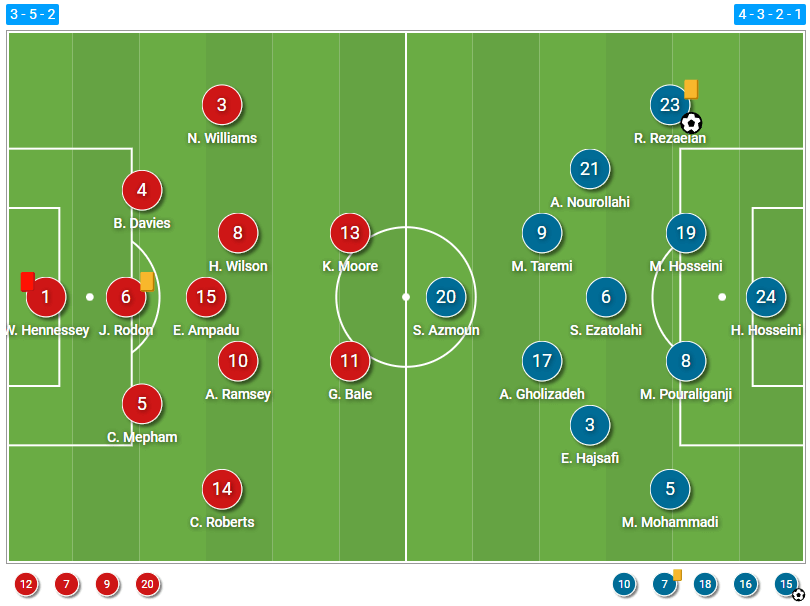
Iran, on the other hand, were utterly disastrous during their heavy defeat to Gareth Southgate’s England. Queiroz reverted from his preferred 4-1-4-1 shape to a more conservative 5-4-1 in the hopes of denying the Three Lions any opportunities. This failed miserably.
Team Melli were carved open on a plethora of occasions and Queiroz’s men looked as though they were uncomfortable playing within the formation throughout the match.
Against Wales on Friday morning, Queiroz went with an entirely different setup, making numerous changes to the starting lineup.
Iran switched from a 5-4-1 to a 4-4-2 as star man Sardar Azmoun came back into the first eleven with Alireza Jahanbakhsh dropping to the bench. Azmoun was used in a strike pairing with Porto’s prolific forward Mehdi Taremi.
Captain Ehsan Hajsafi and Ahmad Nourollahi were the only survivors of a bludgeoned midfield, with Saeid Ezatolahi and Ali Golizadeh making up the rest of the four in the middle of the park.
Milad Mohammadi, Morteza Pouraliganji and Majid Hosseini kept their places in the backline while Rezaeian came in at right-back to complete the defence.
In goal, Alireza Beiranvand suffered a nasty blow to the nose against England and was forced off early. The keeper with the longest throw in football may not return for Team Melli and so Hossein Hosseini took his place in this match, rounding off a new-look Iranian side.
Change of shape
There was so much wrong with Iran’s performance against England on Monday afternoon. Prior to the World Cup, Queiroz had only been in charge for a few friendly matches to prepare his team for the tournament after Dragan Skokic was dismissed, reinstated and then dismissed once more.
In the side’s friendlies against Senegal and Uruguay, they set up in a 4-1-4-1, looking to sit deep for large parts of the game in a low block. From these matches, Iran drew 1-1 with Senegal and beat Uruguay in two solid pre-World Cup results.
Throughout the games, one constant flaw continuously appeared in Iran’s defensive structure which was that their opponents were finding it far too easy to play to attacking players between the lines.
Queiroz knew that England would always look to get the ball into these areas and so switched to a 5-4-1, allowing his centre-backs to be aggressive and step out to close down the English players when they received the ball between the lines. In theory, this seemed completely plausible, but the execution was disastrous.
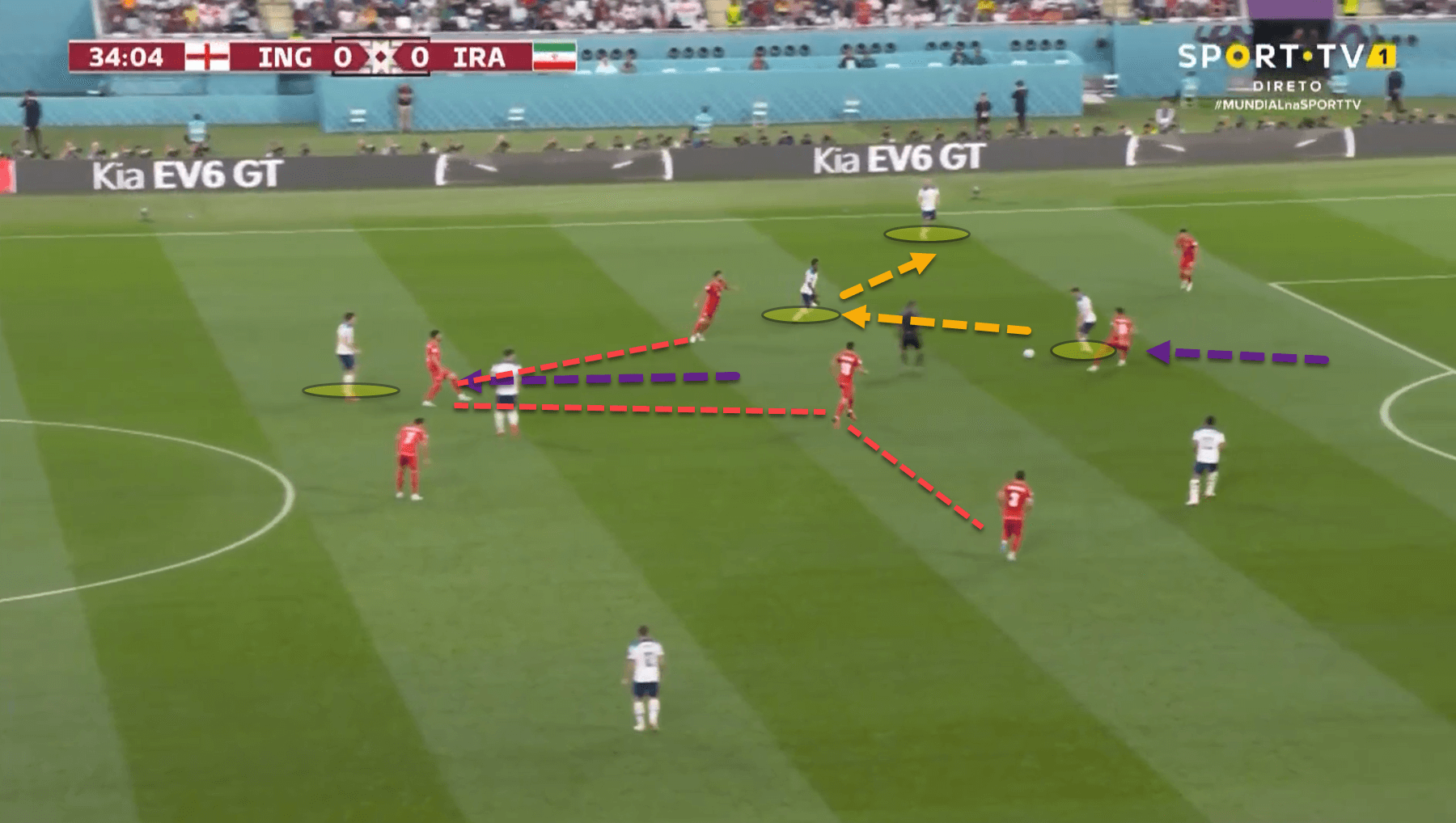
For England’s opening goal, Harry Maguire was put under pressure by the Iranian central midfielder who pushed up out of the midfield line. The ball reached Mason Mount. Iran’s right centre-back was too slow to step out, allowing Mount to lay it off to Raheem Sterling. Sterling squared it to Luke Shaw before the Manchester United left-back’s cross met the head of Jude Bellingham who looped it over the goalkeeper to score.
One of the main causes of this goal was that the central midfielder stepped out to press Maguire, leaving the passing lane into Mount’s feet wide open.
On Friday morning, Queiroz’s switch to a 4-4-2 made Iran much more effective. While there was one less man at the back, Iran had an extra centre-forward pressing, meaning that nobody from the second line had to move out of position and risk leaving space behind them.
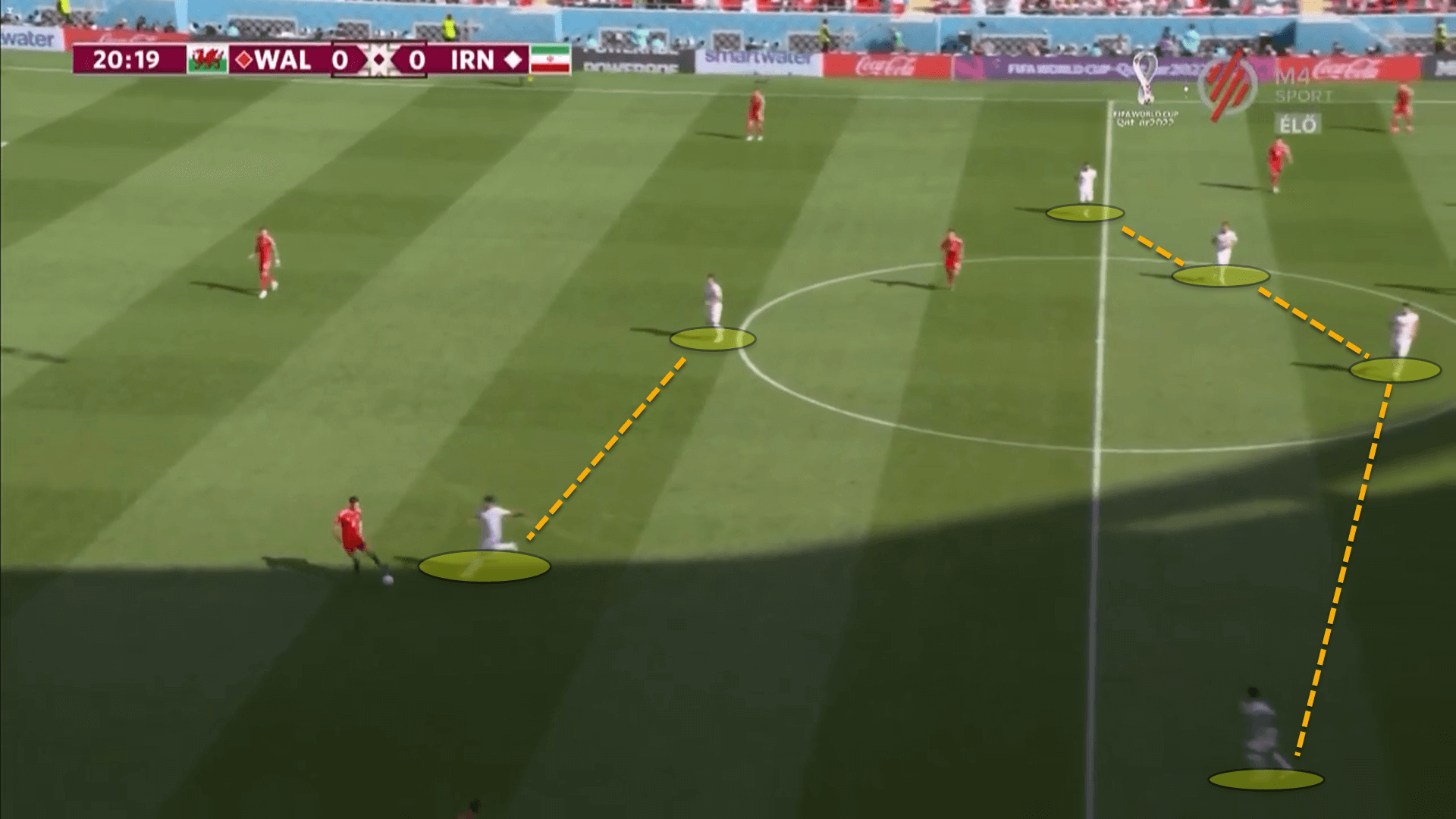
This was a particularly astute tactical change by the 69-year-old manager as Wales tend to create a 3-2 or a 3-1 structure when the ball is with the three centre-backs.
Having just one centre-forward pressing the backline with the help of a midfielder who jumped up to help out would have been disastrous just as it was against England, and Wales would have easily bypassed this pressure to reach players in advanced areas.
Instead, Iran’s centre-forward partnership of Azmoun and Taremi were able to sit on Wales’ deepest midfielder, Aaron Ramsey and Ethan Ampadu, while also pressing the three central defenders when they were sitting in their 4-4-2 mid-to-low defensive block.
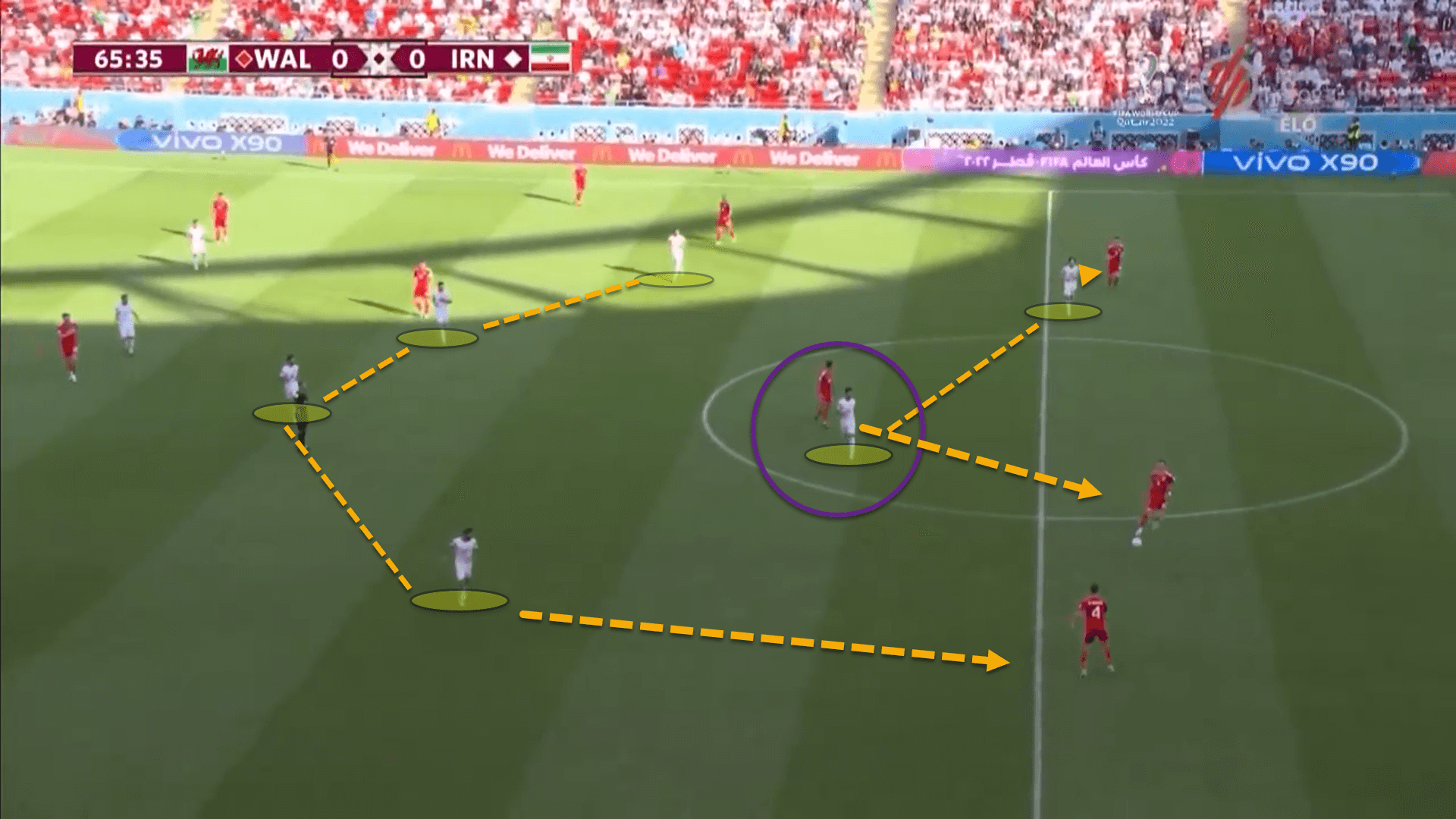
Queiroz’s set-up provided much more stability than the 5-4-1 offered as it stifled Wales’ ability to progress the ball into the midfield and forward line. Page’s side were left to try and play long to Moore up front or else create overloads out wide, both of which were comfortably dealt with.
This logical formation swap was one of the key reasons why Iran managed to keep a clean sheet against Wales and conceded very few opportunities throughout.
Wales’ lack of ideas
Iran defended in an interesting defensive block. The idea behind their set-up was that the players would always mark the nearest player within the team’s shape.
This made things really difficult for Wales as Iran pressed them with intensity in all phases, whether it be in a high, medium or low defensive block.
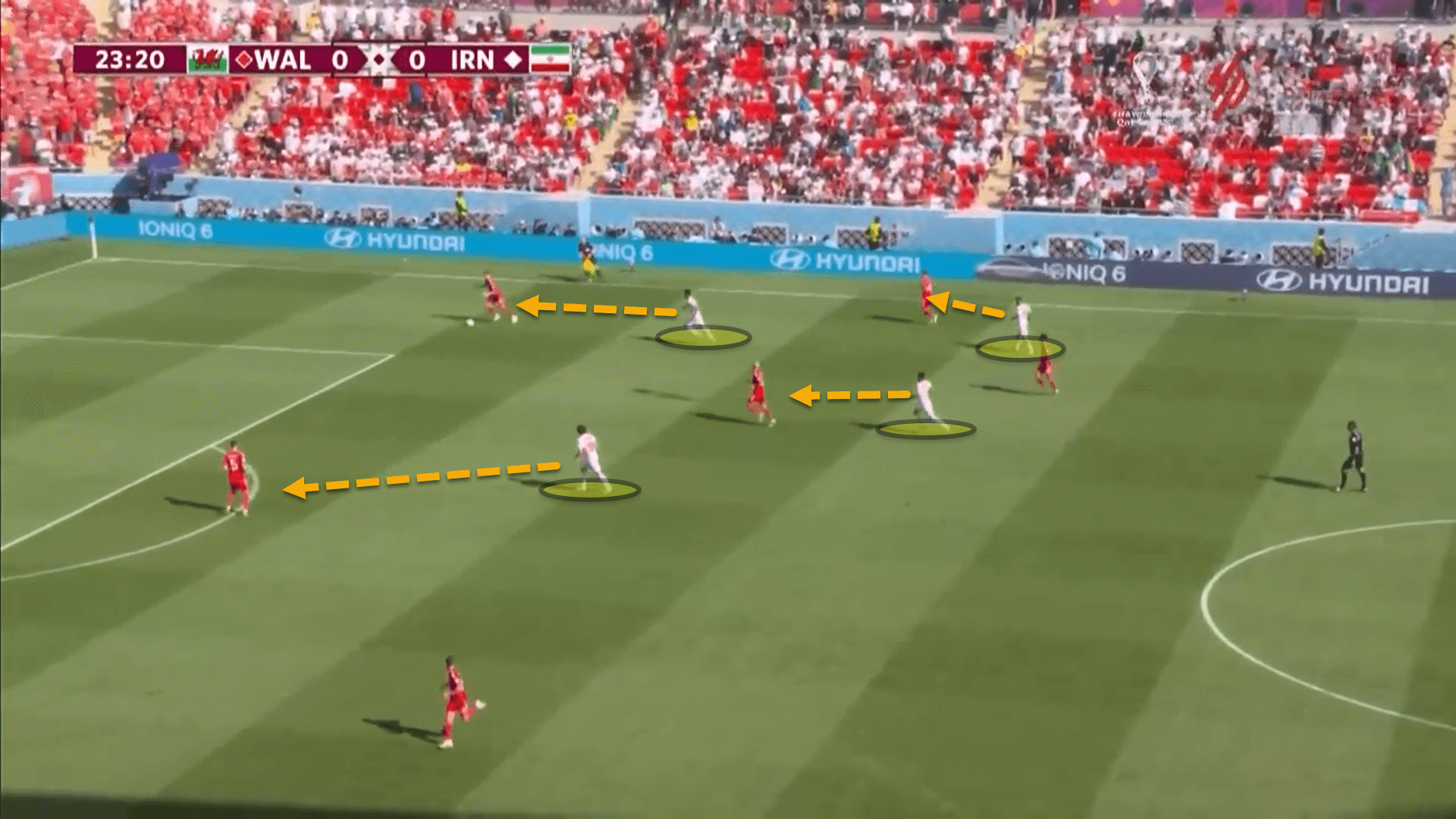
In this example, we can see Iran pressing the Welsh backline and midfield high up the pitch. Each player is tightly marking one of the nearest passing options while the ball carrier is also being pressed by Taremi.
This was a risky strategy by Iran for the main reason why all man-to-man systems struggle. The team defending in such a manner must always bring energy. If the levels drop, off-the-ball movement and quick passing from the opposition can carve them open with ease.
This is one of the reasons why Marcelo Bielsa’s Leeds United were so abhorrent towards the end of the Argentine’s reign at Elland Road. To beat a team who defend in such a way, the attacking side must match their intensity, use plenty of off-the-ball runs and then beat them with their superior quality. Wales did neither.
There was so little movement from the Welsh team to drag markers out of position and create space for others.
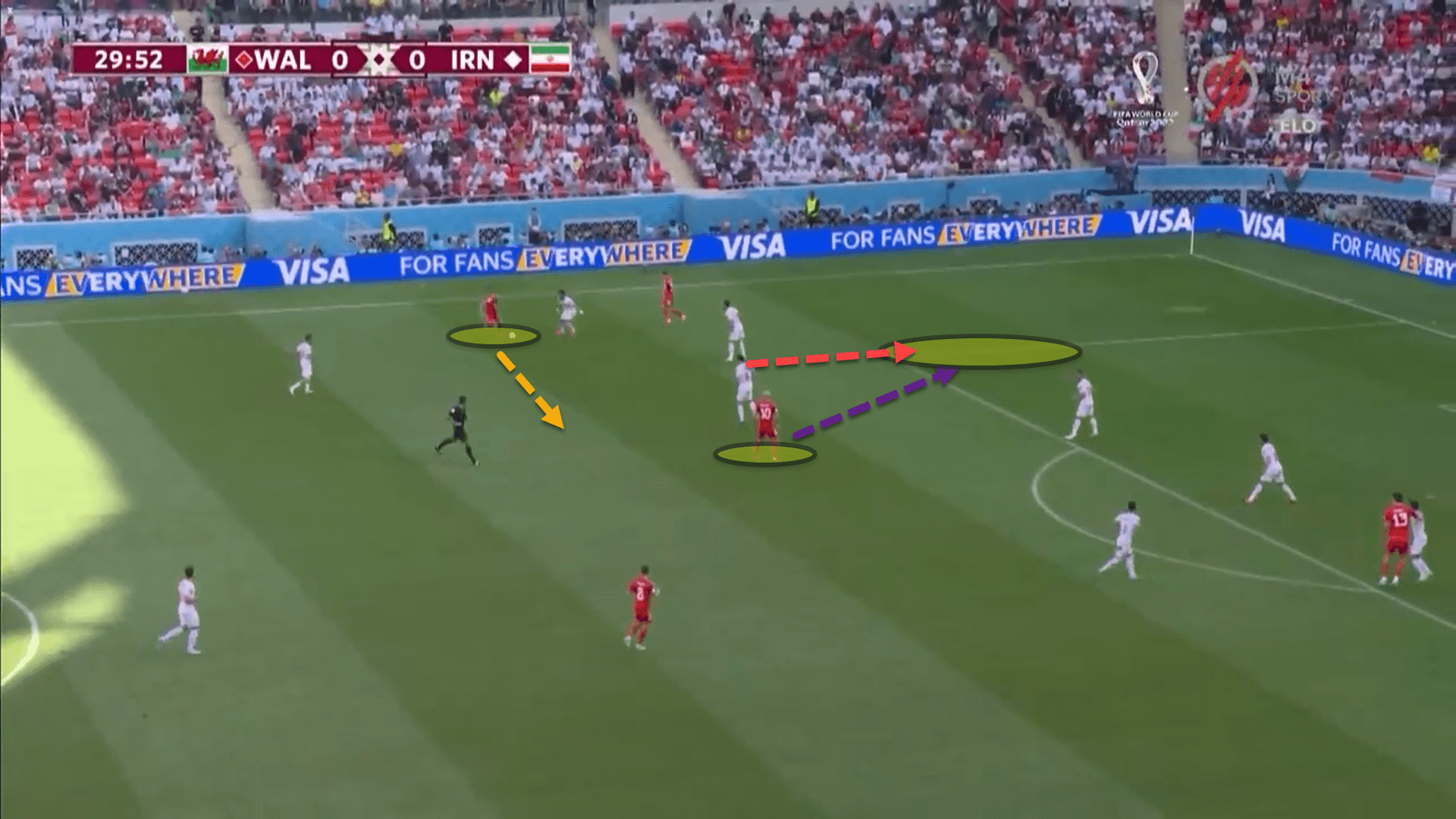
Here, Aaron Ramsey is stagnant as Bale receives the ball over on the left. Ramsey stands still and calls for the ball to feet. If the former Arsenal man made a run into the channel, as illustrated above, it would have dragged the Iranian midfielder with him, opening up space for Bale to run inside and create an opportunity in a better position.
Instead, Ramsey stands still, receives the ball from Bale and is jumped by the midfielder who shuttles him back to the centre circle, avoiding any dangerous play.
Wales had superior players on the pitch than their opponents on the day but were far too stagnant against Iran’s intensity.
One smart tweak that Queiroz made to the team’s defensive block when Iran were sitting deep was to ensure that his ball-far fullbacks were separated from the play and were marking the Welsh wingbacks or wingers, depending on who was holding the width, who were always available for switches of play.
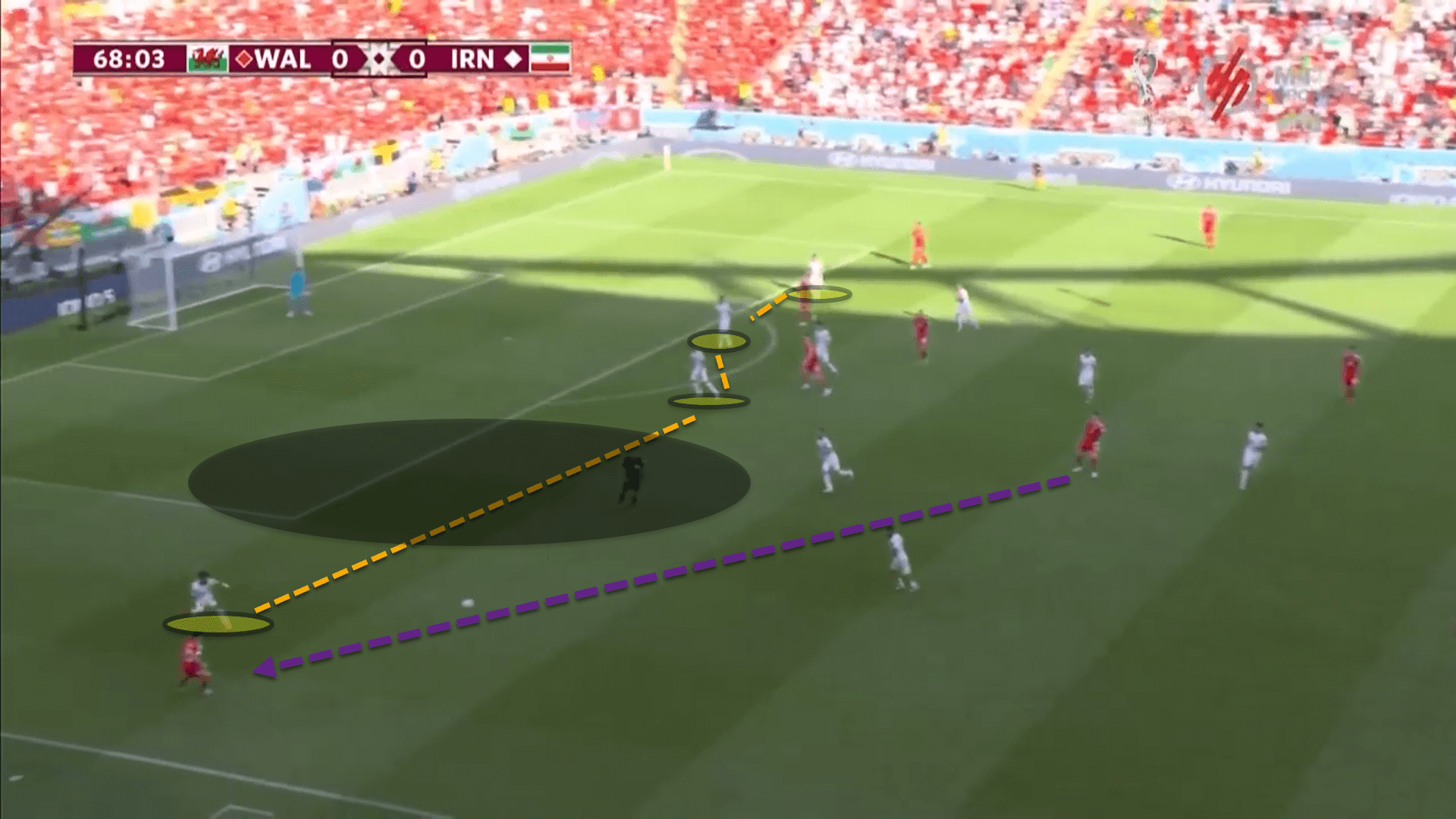
This meant that Wales were unable to switch the play to the ball-far width-holder as, when they did, they were jumped immediately by Iran’s fullbacks which has been highlighted in the above image.
This did mean that there was space between Iran’s fullback and centre-back, but Wales didn’t exploit this free channel.
Iran’s attacking prowess
Iran were not interested in dominating the ball. Queiroz was more than happy to allow Page’s side to have the lion’s share of possession and instead, instructed his players to be defensively efficient, marking the opposition aggressively, and cutting off passing lanes between the lines.
However, the objective was not merely to keep a clean sheet. Queiroz is a firm believer in using defence as a form of attack. As soon as Iran managed to turn the ball over, there was a clear plan from Team Melli to hit the Welsh channels and cause significant damage.
Against England, whilst scoring twice, Iran’s 5-4-1 left Taremi isolated up front to chase long balls. It was almost impossible for Iran to create any decent chances from these attacks as Taremi was forced to do the donkey work himself.
Using a 4-4-2 with two effective strikers up top in a centre-forward pairing of Taremi and Azmoun made Iran much more of a threat going forward.
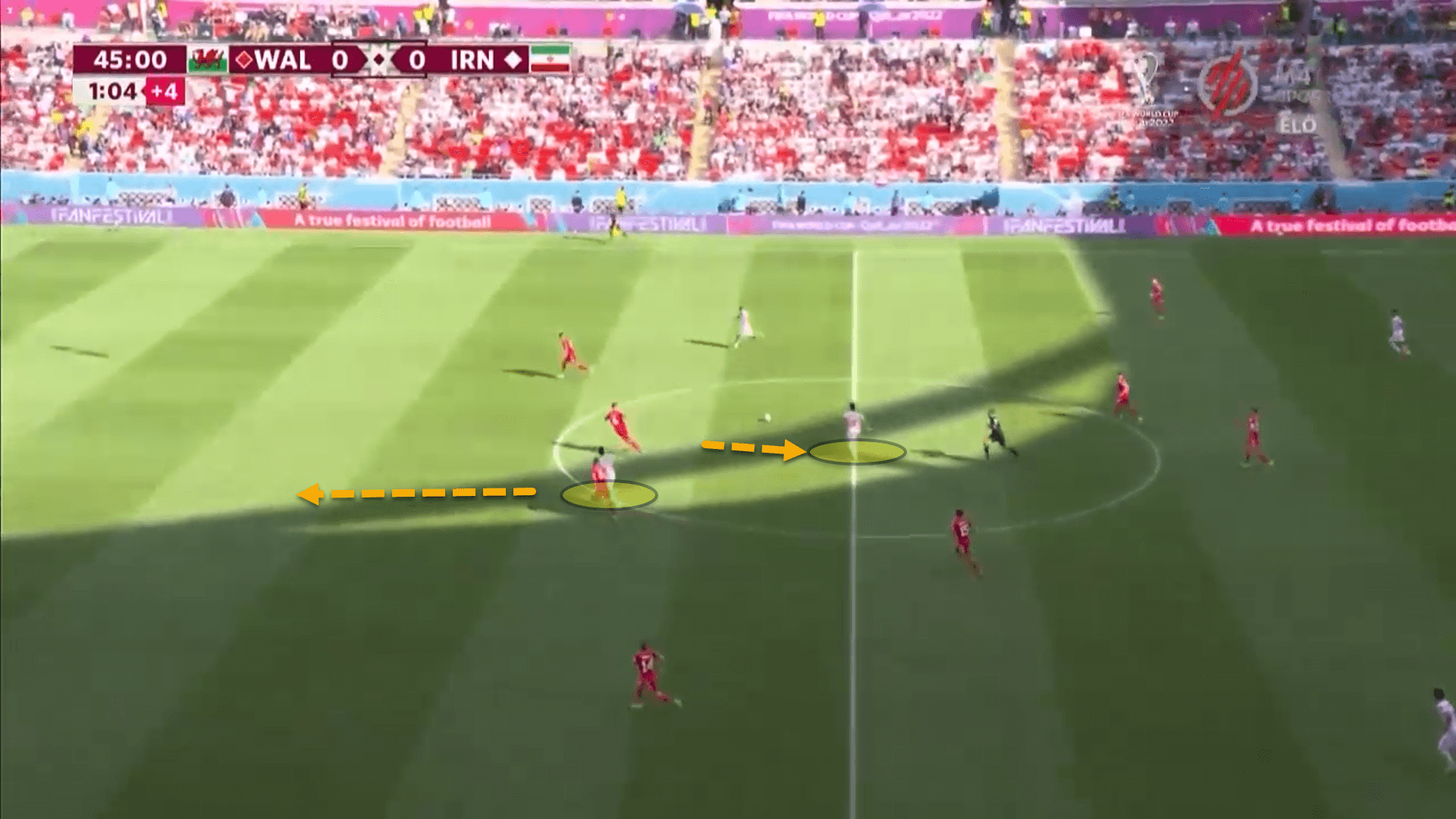
Quite often, as shown in the previous image, one of the front two would drop short to receive to feet while the other would make a run in behind. These are called counter-movements.
Counter-movements are a wonderful example of how to stretch an opponent and cause chaos amongst the backline as the central defenders are unsure about whether or not to track the runner or else go and press the ball.
Overall, long passes into the channels were an excellent method used by Team Melli to get in behind the backline. It sounds so simple, but Wales merely couldn’t deal with the pace of Azmoun and Taremi when they got going.
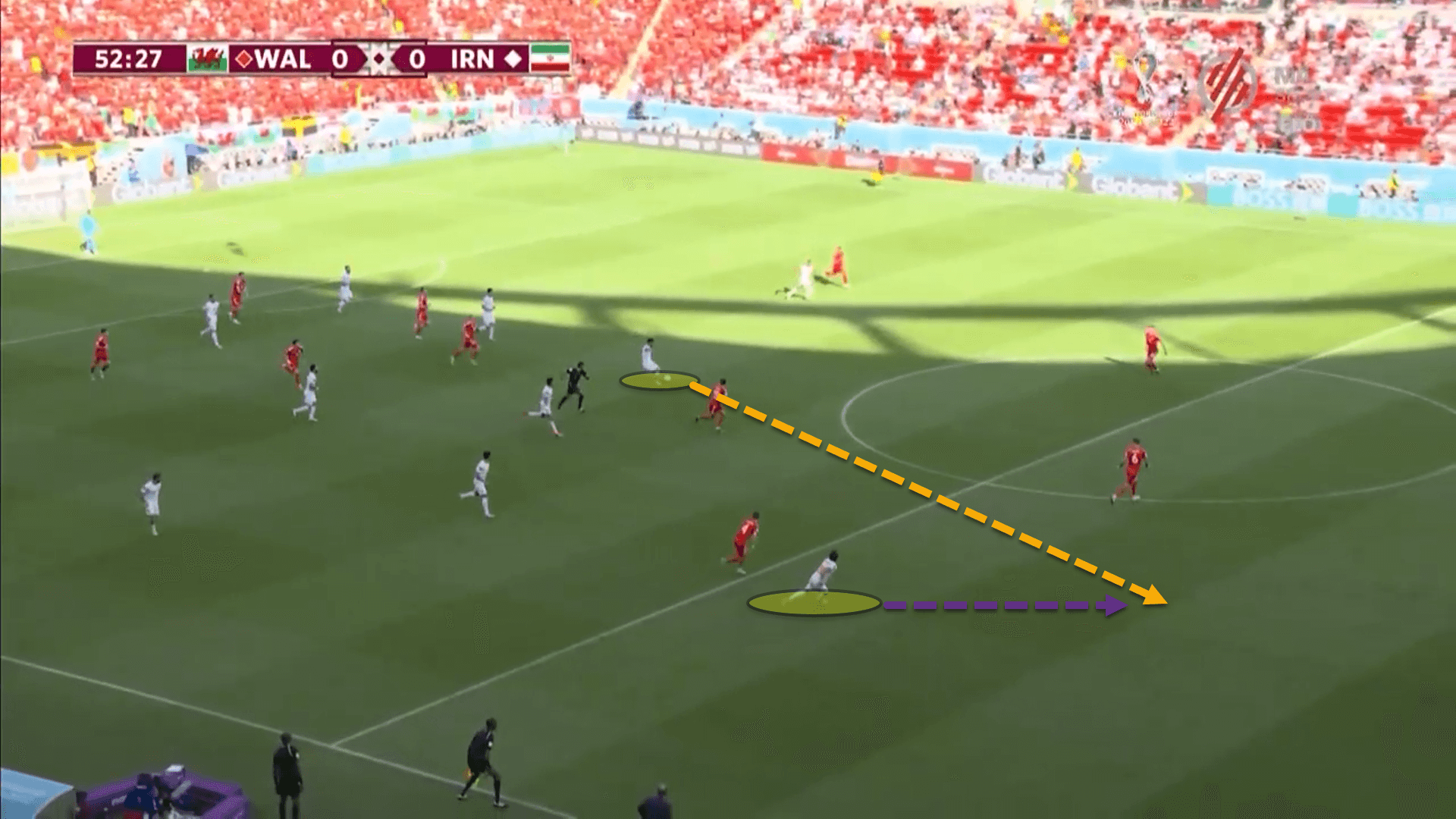
As soon as the ball was turned over in Iran’s favour, the strikers would start running, causing panic amongst the Welsh defence. From the example above, Azmoun managed to latch onto the threaded through ball and rocketed the near post in what would have been a perfect goal for the Middle Eastern side.
The goal that wrapped the game up, in particular, came from this sort of a transitional situation but was helped by the fact that Wales had piled all of their players forward to grab an equaliser and so had little to nobody at the back.
Conclusion
Wales were the favourites going into this fixture, having been impressive in the second half against the USA on Monday night. Meanwhile, many predicted Iran to be psychologically in the dirt after their humiliating loss against England.
However, this couldn’t have been further from reality. Queiroz managed to rally his troops who looked fantastic and carried out the gameplan to perfection as shown in this analysis, creating numerous clear-cut opportunities while limiting Wales’ potent attacking threat. The result was certainly deserved.

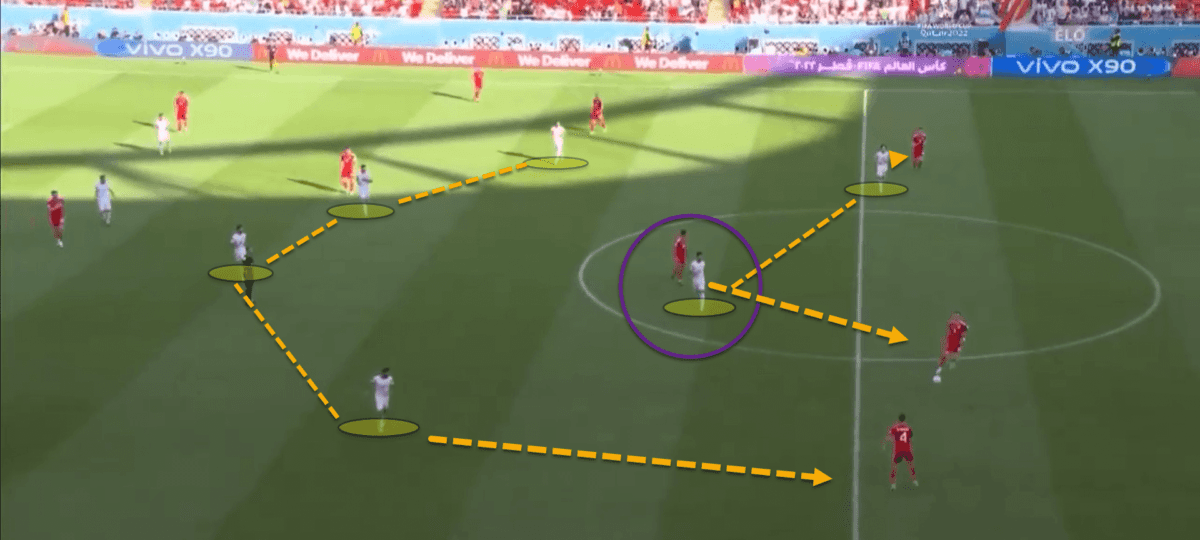




Comments